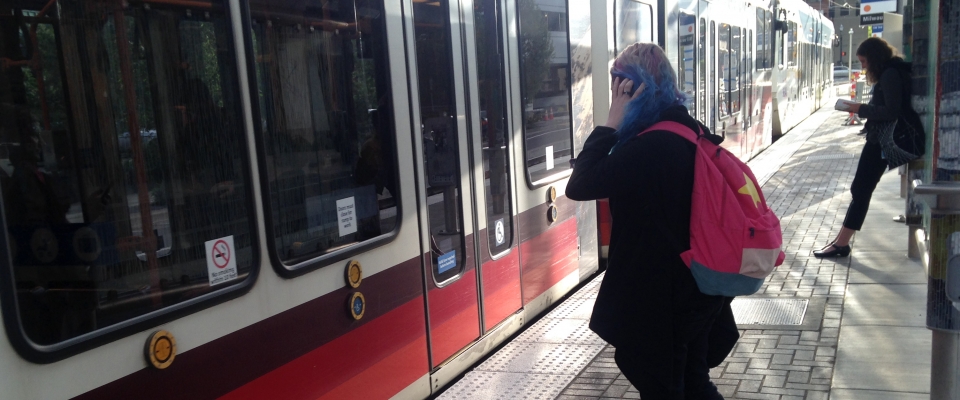What Encourages Portland Youth to Choose Car-Free Mobility?

The latest report from the National Institute for Transportation and Communities (NITC) offers recommendations to increase multimodal travel among youth in Portland, Oregon. Communications strategies derived from focus groups of middle-school aged Portland Public School (PPS) students are aimed at helping the Portland Bureau of Transportation and TriMet, the transit provider for the Portland metropolitan region, to engage more with young riders and encourage them to form lasting habits of car-free travel.
The research team chose to focus on seventh, eighth, and ninth grade students because they will soon be eligible for the free transit service provided by TriMet to all PPS high schoolers. Researchers wanted to focus on this critical decision-making stage to affect long-term behavior change towards opting for non-car travel.
THE RESEARCH TEAM
The project was led by Autumn Shafer, an assistant professor of journalism and communication at the University of Oregon, and assisted by six undergraduate students and one graduate researcher.
RESEARCH OBJECTIVES
This study addressed three primary questions:
- What are the non-car mobility-related attitudes, intentions, and behaviors of Portland youth?
- Which communication channels and settings could be most effective with Portland youth in regards to transportation system information and promotion?
- How are each of the communication strategy themes promoting non-car mobility perceived by Portland youth?
STRATEGIC NON-CAR MOBILITY MESSAGING AND CHANNELS
A previous study based in Florida had recommended three strategic approaches to non-car mobility messaging that could be successful with teenagers:
- Highlight how transit allows teens to be more independent and less reliant on their parents for transportation;
- Highlight the safety benefits of using transit compared to the responsibility of driving; and
- Highlight the high cost of car travel and the better uses of their money.
That said, it’s not a “one size fits all” outcome. The Florida study encouraged transit agencies to conduct their own local market research before embarking on a teenage ridership program.
So, what what works for Portland teens? The research team identified three potential themes: FOMO (fear of missing out), Autonomy, and Generation Z. The FOMO theme, designed to appeal to to teens’ desire for social connection, seeks to portray transit as popular and trendy. The autonomy theme appeals to teens’ desire for independence from their parents, and messages with a Gen Z appeal could impress upon teens that public transit authorities consider the needs and wants of teens when designing services.
The most popular messaging was autonomy. Focus group participants appreciated the option of taking transit instead of relying on their parents for rides. One participant said,
“When I try to ask [my parents] to take me somewhere they wanna be slow about, then I’m just gonna catch the MAX."
The study showed parents as the best source for distribution and endorsement of non-car mobility messages. It seems unlikely that many teens would follow transportation organizations on social media or opt to receive text messages. Outside of parents, Portland youth are most likely to be reached through the TriMet app, billboards or posters near transit stops, ads on YouTube, local radio, and Instagram.
INSIGHTS AND RECOMMENDATIONS
One notable difference between the Florida and Portland studies was that Portland teens rarely, if ever, expressed concerns about negative self-image associated with transit. Portland teens didn’t seem to feel stigmatized when using transit, and expressed that it was normative behavior among their peer groups.
However, the Florida study's emphasis on the safety benefits of transit compared to driving rang untrue to the Portland youth experience. Most of the Portland participants already had experience riding transit, and one of the deeply ingrained narratives around their transit experience is how unsafe and unpredictable it is. They expressed feelings of uncertainty, anxiety, and concerns around sexual harassment that they have personally experienced when riding Portland public transit. One participant said:
“Um, men, being a girl. Men when they come up to you and they approach you and they’re like… grown and you’re like, I’m a little girl, or you’re just not interested at all. And they don't take no for an answer. That’s really scary cause I’ve been groped and grabbed and it’s because I said ‘no’. They just don’t listen.”
Effective messaging to convince these kids that transit is safer would likely need to contain new information, including better ways to report incidents and how to protect themselves from harassment. The final report offers qualitative coding and quantitative content analysis of the findings, with recommendations for transit and other agencies wishing to engage more with young riders.
This research was funded by the National Institute for Transportation and Communities, with additional support from the University of Oregon School of Journalism and Communication.
RELATED RESEARCH
To learn more about this and other NITC research, sign up for our monthly research newsletter.
- Framing Livability: A Strategic Communications Approach to Improving Public Transportation in Oregon
- The Contribution of Transportation and Land Use to Citizen Perceptions of Livability in Oregon MPOs
- Community-based Assessment of Transportation Needs to inform City of Portland Smart Cities Plan
The National Institute for Transportation and Communities (NITC), one of five U.S. Department of Transportation national university transportation centers, is a program of the Transportation Research and Education Center (TREC) at Portland State University. The NITC program is a Portland State-led partnership with the University of Oregon, Oregon Institute of Technology, University of Utah and new partners University of Arizona and University of Texas at Arlington. We pursue our theme — improving mobility of people and goods to build strong communities — through research, education and technology transfer.
